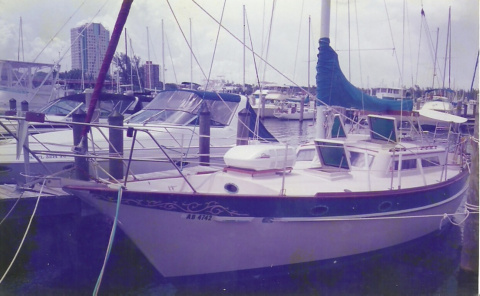LIVEABOARD SLEEPING
Size Counts. You will be spending 1/3 of your liveaboard time sleeping, so make sure you have a comfortable berth.
You want something that is long enough and wide enough that you are not forced into sleeping in the fetal position only.
Lie down and check it out before you buy the boat. Have your partner or a friend lie down with you. You want liveaboard sleeping to be as comfortable as it was in your home ashore.
Also look for ventilation. Is there a nice big hatch above the berth that you can open on hot nights and attach a wind scoop to? Are there opening side ports that will give you some cross breeze?
These are good things to look for even if the boat has air conditioning. If it does have air conditioning, where will the air be blowing? On your feet, your face or somewhere else?
Check it out.
Mattress Quality
Most boats have foam rubber mattresses that are about 4 inches thick. Thicker is better, of course, and some foam is better than others. Innerspring mattresses are great and so are some air mattresses and memory foam models.
If the mattress on the boat you are buying is miserable, be ready to spend some bucks on a good mattress as soon as you can. Quality liveaboard sleeping time is priceless!
Vee Berth
A vee berth in a sailboat is located forward and is usually not very comfortable unless you are sleeping by youself. The bow squeezes the berth into a narrow zone at the forward end of the boat. Two people will have a hard time putting their four feet up in that pointy vee. Some people who live aboard alone put their heads up in the pointy vee instead of their feet. Take a real careful look at the vee berth if that's where you plan to sleep.
Here is a picture looking forward into the very roomy vee berth on AWOL, my Island Packet 26 MKII. The blue box in the foreground is where I kept my foldable clothes, socks and underwear. My hanging clothes were on a big hook on the bulkhead just around the corner to starboard.
The vee berth in my CSY 33 was not quite as big as the one on the Island Packet, but the stateroom was larger with a couple of hanging lockers and a chest of drawers built in.
I installed a portable air conditioner in the hatch above the bunk which did a good job of keeping the sleeping area super cool during the hot Florida summers.
The sleeping cabin had a door that closed it off from the rest of the boat. You can see the door knob in the lower left corner of the photo.
Island Berth
Bigger boats have the space for island berths.
These are beds that you can walk completely around on three sides just like your bed at home. They make liveaboard sleeping akin to a luxurious hotel room.
It makes the bed easy to make up, but it takes a lot of space in your sleeping cabin.
These island berths are quite often installed in aft cabins where the width of the boat is greater than it is up at the bow.
Pullman Berth
A pullman berth fits along one side of your sleeping quarters and gives you standing room on the other side.
It's also easier to make up than a vee berth, and some of them are large enough to sleep two people.
A good example of the pullman berth is in the Nonsuch 30 Ultra, a cat rigged sailboat.
The double pullman berth is tucked away up forward on the port side of the boat. It is long enough for me, and the Nonsuch 30 is one of the boats I am considering when I resume my liveaboard life.
Quarter Berth
These berths are normally located in either the port or starboard aft quarter of the boat.
They usually take up space under the cockpit seats and are a bit like sleeping in a coffin.
They are snug and secure, however, and a great place to sleep while underway because it keeps you close to the cockpit.
Most quarter berths get used for storage instead of liveaboard sleeping.
Ventilation
One of the great things about living aboard is getting close to nature. In Florida summers, however, most liveaboards have air conditioning and keep the boat tightly buttoned up from May through October.
Some people have learned to live without air conditioning, and have learned how important it is to have a boat with good ventilation. This means the boat should have plenty of opening hatches and ports, and plenty of low energy drain fans.
My CSY 33 had several opening deck hatches and opening ports.
I installed a Cruise n Carry air conditioner on the forward hatch.

Over 6,458 fans can't be wrong.
See if living on a boat is the life
for you. Like us on Facebook.
20190318-25-135
By Mike Miller, Copyright 2012-2023 Living-Aboard.com



